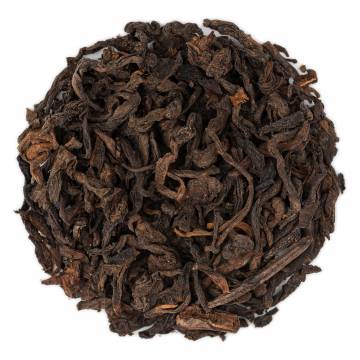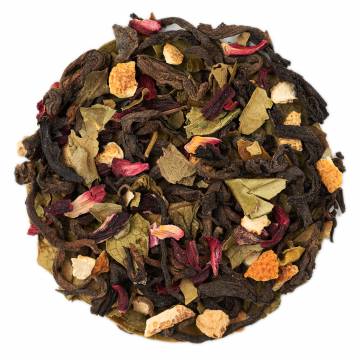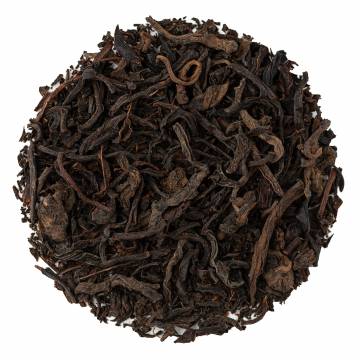Wholesale/Bulk Pu-Erh Tea Options
Shanti Tea Importers offers a remarkable Pu-Erh Tea Collection, available wholesale and bulk for tea retailers and brands across the United States and Canada. Our range features premium Pu-Erh teas known for their rich flavours and numerous health benefits. We provide private and white-label customization, allowing you to create tailored packaging and branding to meet your needs. Elevate your product lineup and delight your customers with the exceptional quality of our Pu-Erh teas by partnering with Shanti Tea Importers today.
What is Pu-Erh tea?
Pu-Erh tea is a fermented tea originating from the Yunnan province in China, specifically named after the Pu’er region, where it was traditionally produced and traded. This unique tea is known for its distinct production process and complex flavour profile. There are two main types of Pu-Erh tea: Sheng (Raw) Pu-Erh and Shou (Ripe) Pu-Erh. Sheng Pu-Erh undergoes a natural fermentation process over several years, starting as a green tea and developing darker, more intricate flavours as it ages. In contrast, Shou Pu-Erh is made using an accelerated fermentation technique developed in the 1970s, resulting in a dark, rich tea with earthy and mellow notes.
Pu-Erh tea production begins with the harvesting of leaves from ancient tea trees. These leaves are then withered, pan-fired, rolled, and sun-dried to create “Mao Cha” or rough tea. For Sheng Pu-Erh, the Mao Cha is compressed into cakes, bricks, or other shapes and left to age naturally. For Shou Pu-Erh, the Mao Cha is piled, dampened, and fermented in a controlled environment before being compressed. The aging process is crucial for Pu-Erh tea, allowing it to develop more profound and complex flavours, similar to fine wine over time. High-quality Pu-Erh teas are often aged for decades, improving each year.
The flavour profile of Pu-Erh tea varies significantly between its two types. Sheng Pu-Erh is fresh, floral, and sometimes astringent when young, but it becomes sweeter, smoother, and more complex as it ages. On the other hand, Shou Pu-Erh is rich, soft, and earthy with notes of dark chocolate, wood, and occasionally a slight sweetness. Pu-Erh tea is also believed to offer several health benefits, including aiding digestion, reducing cholesterol levels, and promoting weight loss. It is rich in antioxidants and has antimicrobial properties.
Brewing Pu-Erh tea typically involves using a high leaf-to-water ratio and short steeping times, allowing for multiple infusions that each bring out different layers of flavour. Pu-Erh tea’s unique characteristics and aging potential make it a treasured choice among tea enthusiasts, especially those who appreciate the depth and complexity that come with well-aged teas.
What are the benefits of drinking Pu-Erh tea?
Drinking Pu-Erh tea may offer a variety of potential health benefits, many of which stem from its unique fermentation process and rich nutritional profile. Here are some of the key benefits that have been suggested by research:
- Aids Digestion: Pu-Erh tea is thought to promote healthy digestion and balance the digestive system[1]. Drinking Pu-Erh tea after meals may help break down fats and improve digestion.
- Reduces Cholesterol Levels: Studies have suggested that Pu-Erh tea may help lower LDL (harmful) cholesterol levels while increasing HDL (good) cholesterol levels[2]. This is potentially beneficial for heart health and may help reduce the risk of cardiovascular diseases.
- Promotes Weight Loss: Pu-Erh tea is often consumed as a weight loss aid. It may help boost metabolism, increase fat burning, and prevent the body from producing new fat cells[3]. Additionally, it could act as a natural appetite suppressant.
- Boosts Energy and Mental Alertness: Pu-Erh tea’s caffeine content can provide a gentle energy boost without the jittery effects often associated with coffee. This may help improve mental alertness and focus.
- Detoxifies the Body: Pu-Erh tea may help detoxify the body by removing toxins and impurities[4]. Its natural antioxidants may support liver function and enhance the body’s ability to eliminate waste.
- Improves Cardiovascular Health: Beyond potentially lowering cholesterol, Pu-Erh tea contains antioxidants and anti-inflammatory properties that may contribute to overall heart health[5]. It may also help improve blood circulation and reduce the risk of heart-related conditions.
- Enhances Immune Function: The fermentation process of Pu-Erh tea increases its concentration of beneficial microorganisms, which may strengthen the immune system[6]. Regular consumption could help the body fend off common illnesses and infections.
- Rich in Antioxidants: Pu-Erh tea is packed with antioxidants, which combat free radicals in the body[7]. This helps reduce oxidative stress, which may lower the risk of chronic diseases, and promote overall health.
- Supports Bone Health: Some studies suggest that the polyphenols and other compounds in Pu-Erh tea may help improve bone density and reduce the risk of osteoporosis, particularly in older adults[8].
- Drinking Pu-Erh tea may offer a range of potential health benefits. However, it’s important to consult with your doctor or a healthcare professional if you have any concerns or underlying health conditions before incorporating Pu-Erh tea into your diet.
References:
- Liu, W., et al. (2016). Journal of Agricultural and Food Chemistry. https://pubmed.ncbi.nlm.nih.gov/27477844/
- Huang, H. C., et al. (2012). Journal of Agricultural and Food Chemistry. https://pubmed.ncbi.nlm.nih.gov/22151245/
- Wang, L., et al. (2016). Food & Function. https://pubmed.ncbi.nlm.nih.gov/26895187/
- Chen, J., et al. (2013). Journal of Medicinal Food. https://pubmed.ncbi.nlm.nih.gov/23627743/
- Jing, Y., et al. (2013). Phytomedicine. https://pubmed.ncbi.nlm.nih.gov/23598146/
- Hong, K. J., et al. (2011). Food and Chemical Toxicology. https://pubmed.ncbi.nlm.nih.gov/21443992/
- Lin, J. Y., et al. (2008). Journal of Agricultural and Food Chemistry. https://pubmed.ncbi.nlm.nih.gov/18710216/
- Shen, C. L., et al. (2009). Journal of Agricultural and Food Chemistry. https://pubmed.ncbi.nlm.nih.gov/19947668/
What is the difference between Organic Pu-Erh tea and Pu-Erh tea?
The primary difference between organic Pu-Erh tea and regular Pu-Erh tea is their cultivation and production practices. Organic Pu-Erh tea is grown without synthetic fertilizers, pesticides, or herbicides, relying instead on natural methods such as composting, crop rotation, and organic fertilizers to maintain soil fertility and control pests. This approach enhances the environmental sustainability of tea production, promotes biodiversity, and reduces pollution. To be labelled organic, the tea must meet specific standards set by certification bodies like USDA Organic or EU Organic, ensuring adherence to strict organic farming guidelines.
Regular Pu-Erh tea may be grown using conventional farming methods, often involving synthetic chemicals to boost growth and manage pests. While these practices can lead to higher yields, they may also result in environmental concerns such as soil degradation, water contamination, and reduced biodiversity. Regular Pu-Erh tea does not require certification and may lack transparency regarding its farming practices.
From a health and safety perspective, organic Pu-Erh tea is preferred by many consumers seeking to avoid potential residues of synthetic chemicals on the tea leaves. The absence of these residues makes organic tea a healthier option for those concerned about pesticide and herbicide exposure. Although regular Pu-Erh tea is generally safe for consumption, there may be concerns about such residues, even though many producers conduct rigorous testing to meet safety standards.
The flavour of organic Pu-Erh tea can be influenced by its natural farming methods, potentially resulting in subtle differences compared to non-organic tea. Some enthusiasts believe that organic practices enhance the purity and complexity of the tea’s flavour. However, high-quality regular Pu-Erh tea can also offer excellent flavour profiles, largely dependent on the producer’s skill and the tea leaves’ quality.
Lastly, organic Pu-Erh tea costs are often higher due to the more labour-intensive farming practices and certification expenses. Regular Pu-Erh tea tends to be more affordable, as conventional farming methods yield higher quantities at lower costs. In summary, choosing organic and regular Pu-Erh tea involves farming practices, environmental impact, health concerns, flavour differences, and cost, with personal preferences and values playing a significant role in the decision.




